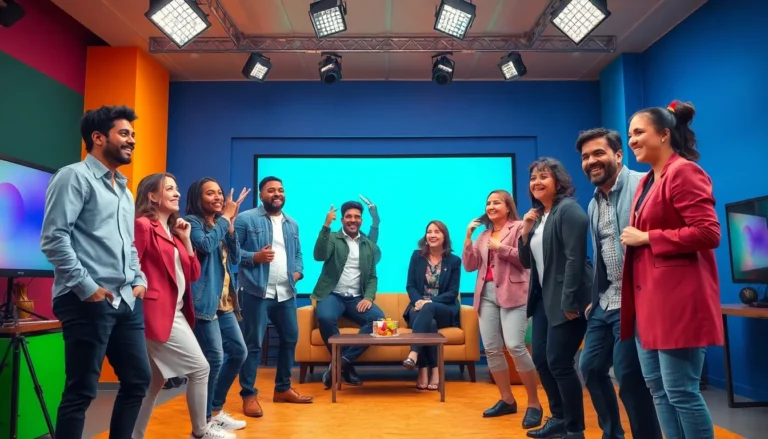Table of Contents
ToggleWhen it comes to smartphones, Apple fans often find themselves in a heated debate: iPhone 11 or iPhone 12? It’s like choosing between pizza and tacos—both delicious but oh so different. The iPhone 11, with its trusty dual-camera setup and vibrant colors, has been a reliable companion. But the iPhone 12 struts in with a sleek design and 5G capabilities that make it feel like the cool kid on the block.
Overview of iPhone Models
Apple offers a range of iPhone models, notably the iPhone 11 and iPhone 12. Both smartphones maintain high-quality features and performance. The iPhone 11 features a dual-camera system, including a 12 MP ultra-wide lens and a standard 12 MP lens, allowing for versatile photography. Users appreciate the vivid color options available for the iPhone 11, which include black, white, green, yellow, purple, and red.
In contrast, the iPhone 12 introduces a more refined design with flat edges and a ceramic shield front for enhanced durability. This model also utilizes a dual-camera setup, which includes improved low-light performance. Enhanced Night mode capabilities further improve photography outcomes in dim conditions.
Regarding display, the iPhone 11 comes with a 6.1-inch Liquid Retina HD display, providing a sharp and vibrant viewing experience. Comparing this, the iPhone 12 uses a 6.1-inch Super Retina XDR display, offering superior brightness and color accuracy, benefiting users who consume media regularly.
5G capabilities set the iPhone 12 apart from the previous model. While the iPhone 11 only supports 4G LTE, the iPhone 12 allows for faster download and streaming speeds in areas with 5G coverage. Battery life remains similar, with both models providing strong performance throughout the day.
These key differences, along with improved processing power in the iPhone 12 via the A14 Bionic chip, highlight the advancements Apple introduced while maintaining the beloved features of the iPhone 11. Buyers often consider these factors when choosing between models, as both devices offer unique benefits tailored to different user needs.
Design Differences

Both the iPhone 11 and iPhone 12 showcase distinct design characteristics that influence user choice. The transition in design reflects Apple’s commitment to aesthetics and functionality.
Size and Weight Comparison
iPhone 11 measures 6.1 inches in height and weighs 194 grams. In comparison, iPhone 12 remains the same height but reduces weight to 164 grams, enhancing portability. Slimmer profiles contribute to a different feel in hand. The iPhone 12’s dimensions reflect a shift towards a sleeker design with flat edges, contrasting with the iPhone 11’s rounded edges. Users often notice this difference when holding the devices side by side.
Color Options
Color choices also distinguish these models. iPhone 11 offers a palette of six vibrant colors: black, white, green, yellow, purple, and red. On the other hand, iPhone 12 presents more understated and sophisticated options, including black, white, blue, green, and product red. The iPhone 12’s color finishes feature a glossy look, while the iPhone 11 has a more matte finish. These variations influence personal style and preference, providing buyers with tailored options.
Display Features
The display features of the iPhone 11 and iPhone 12 highlight significant advancements. Understanding these differences aids in making an informed choice.
Screen Technology
The iPhone 11 utilizes a 6.1-inch Liquid Retina HD display. This technology ensures vibrant colors, but the iPhone 12 introduces a 6.1-inch Super Retina XDR display. Enhanced OLED technology in the iPhone 12 facilitates richer colors and deeper blacks. Additionally, the improved contrast ratio makes for a more immersive viewing experience.
Brightness and Resolution
Brightness and resolution vary between the two models. The iPhone 11 reaches a maximum brightness of 625 nits, while the iPhone 12 offers up to 1200 nits for HDR content. Resolution in both devices stands at 1792 x 828 pixels. However, the iPhone 12’s higher brightness level enhances visibility in bright conditions, making it more suitable for outdoor use. Overall, these display attributes set the iPhone 12 apart in delivering a superior visual experience.
Performance Upgrades
Performance upgrades mark a significant difference between the iPhone 11 and iPhone 12. Enhanced processing power and efficiency contribute to the overall user experience.
Processor Specifications
The iPhone 12 features Apple’s A14 Bionic chip, highlighting a leap in processing performance. This chip utilizes a 5-nanometer architecture, resulting in better power efficiency and speed compared to the iPhone 11’s A13 Bionic chip. Users experience faster app launches and improved gaming performance with the A14. Increased efficiency also prolongs battery life, enabling longer smartphone usage without charging. Multi-core performance shows noticeable improvements, further benefiting multitasking capabilities for heavy usage scenarios. Users enjoy the benefits of advanced machine learning with the A14, enhancing photography and video processing as well.
Battery Life
Battery life remains comparable between both models, but slight enhancements exist in the iPhone 12. Both the iPhone 11 and iPhone 12 support up to 17 hours of video playback. However, the iPhone 12’s improved efficiency with the A14 Bionic chip may lead to marginally better endurance in real-world usage. Various factors, like display technology and software optimizations, also play a role in battery performance. Real-world tests indicate that typical users may find slightly longer durations between charges on the iPhone 12, especially during tasks utilizing 5G. Charging capabilities maintain similarity; both models support fast charging and wireless charging options.
Camera Improvements
The iPhone 12 offers notable camera enhancements over the iPhone 11.
Camera Specs and Features
Both models feature a dual-camera system with 12 MP ultra-wide lenses and standard lenses. Users appreciate the iPhone 11’s reliable performance, yet the iPhone 12 enhances this experience with an improved sensor design. The iPhone 12’s lenses capture images with better clarity. Photographers benefit from Smart HDR 3 technology present in the iPhone 12. This feature enables more dynamic range in photographs. For those interested in videography, the iPhone 12 supports Dolby Vision HDR recording up to 30 frames per second, compared to the iPhone 11’s more limited capabilities.
Night Mode and Low-Light Performance
Night mode appears on both the iPhone 11 and iPhone 12, yet the latter shows marked improvements. Low-light performance shines with the iPhone 12, thanks to its advanced image processing. Night mode activates automatically on the iPhone 12, ensuring optimal results in dim conditions. Users notice brighter, more detailed images at night with the iPhone 12. The iPhone 11, while capable, may not deliver the same level of performance in challenging lighting. Users witnessing low-light capabilities recognize a distinct advantage in the iPhone 12’s camera system.
Connectivity Enhancements
The iPhone 12 introduces significant advancements in connectivity compared to the iPhone 11.
5G Compatibility
5G connectivity defines the iPhone 12, allowing faster download speeds and improved streaming. Users experience speeds up to 4 Gbps based on network availability. In contrast, the iPhone 11 only supports 4G LTE, limiting internet speed and performance during high-traffic usage. The 5G support on the iPhone 12 facilitates smoother experiences for gaming and video calls. It also accommodates the growing demand for high-speed internet as more applications require bandwidth.
Other Connectivity Features
Bluetooth 5.0 identifies another key enhancement in the iPhone 12. This version provides a more extended range and improved data transfer rates compared to the Bluetooth 4.2 in the iPhone 11. Both models support Wi-Fi 6, which enhances internet connectivity, but the iPhone 12 gains an edge with better performance in congested areas. Additionally, the iPhone 12 integrates MagSafe technology, facilitating easier wireless charging and a stronger magnetic connection for accessories. Both devices feature dual SIM capabilities. However, the iPhone 12 enhances flexibility with support for eSIM, enabling users to have two active numbers simultaneously.
Pricing and Availability
Pricing varies significantly between the iPhone 11 and iPhone 12, reflecting their respective features and release dates. As of October 2023, the iPhone 11 starts at approximately $499 for the base model with 64 GB storage. The iPhone 12, introduced with more advanced features, starts around $699 for the same storage capacity. Price adjustments occur frequently, so checking current retail offers is advisable.
Availability also plays a critical role when considering these devices. The iPhone 11 remains available at major retailers and online platforms, ensuring potential buyers can find it without difficulty. In contrast, the iPhone 12 may have limited stock at certain retailers as newer models get released, affecting its accessibility. Apple’s website usually provides the most accurate stock levels for both models.
Additionally, trade-in programs can impact pricing. Apple offers trade-in options that allow users to lower the purchase costs for either model based on the condition of their current device. Trade-in values fluctuate, thus checking for the latest estimates through Apple or authorized retailers can maximize savings.
Online marketplaces present another avenue for purchase. Various resellers often list both models, sometimes offering discounts or bundle deals. It’s essential for buyers to verify the warranty and return policies when considering third-party sellers to ensure a safe transaction.
Overall, understanding the pricing and availability helps consumers make informed decisions between the iPhone 11 and iPhone 12, balancing features and budget effectively.
Choosing between the iPhone 11 and iPhone 12 ultimately depends on individual preferences and needs. The iPhone 11 offers solid performance and vibrant colors for those who appreciate a reliable device without the latest features.
On the other hand, the iPhone 12 stands out with its modern design and advanced capabilities like 5G connectivity and improved camera performance.
For users who prioritize cutting-edge technology and enhanced durability, the iPhone 12 is the clear winner. Understanding these differences helps consumers make an informed decision that aligns with their lifestyle and budget.





